
Guess who decided to drop by STOMPer Meg's home on Vesak day? It was a friendly, though uninvited, little bat!
Said the STOMPer:
"At 4am, I woke up to a faint chirping, only to find it hiding near my kitchen ceiling.
"I called all pest controllers only to find out none are specializing in capturing this animal.
"It's still in my house."
The photo is a little fuzzy, but still clear enough to show that this is a pouched tomb bat (Saccolaimus saccolaimus), a common and widespread species in Singapore.

Pouched tomb bat, Singapore;
(Photo by kwokwai76)
The pouched tomb bat roosts in colonies within rock crevices, hollow trees, and buildings, and like many other bat species, emerges at dusk to feed on insects. It goes by several names; pouch-bearing bat and pouched bat are other names for it, Wikipedia lists it as the naked-rumped pouched bat, while in Australia it is known as the bare-rumped sheathtail bat.
Regardless of its common name, this is a species with a wide distribution, from India and Sri Lanka all the way to New Guinea and northern Australia.
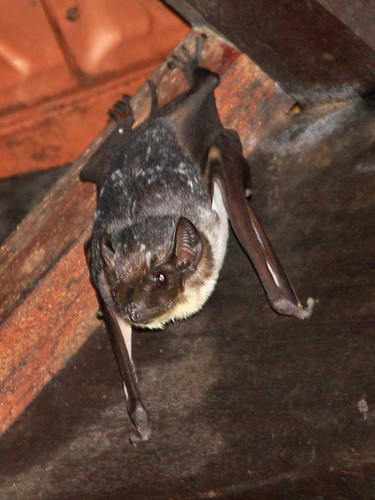
Pouched tomb bat, Singapore;
(Photo by kwokwai76)
The pouched tomb bat belongs to the family Emballonuridae, a family of 47 species of bat found throughout the tropics and sub-tropics, and commonly known as the sheath-tailed or sac-winged bats. Both names allude to the unique morphology of these bats.
In most bat species, the hind legs are joined together by a membrane called the uropatagium, which often also encloses the tail. You can see an example below.

Bicoloured leaf-nosed bat, Bukit Timah Nature Reserve;
(Photo by Leong Tzi Ming)
In the emballonurid bats, however, the tip of the tail protrudes from the middle of the uropatagium.
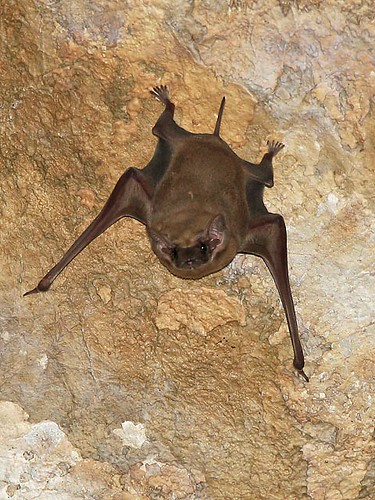
Black-bearded tomb bat (Taphozous melanopogon), Thailand;
(Photo by kwokwai76)
In flight, the bat can further extend the uropatagium by stretching its legs; the loose sheath around the tail easily slides back and forth over the tail vertebrae. This unique ability to control the size and shape of the uropatagium gives the emballonurid bat exceptional control over its steering and turning capabilities while pursuing insects in the air. It's a shame there aren't any readily accessible photographs of the tail of an emballonurid bat to illustrate this.
The other common name of sac-winged bats is due to the presence of glandular sacs in the wings of many species. These glands may play a role in scent-marking and communication. The pouched tomb bat lacks wing sacs, but has a large glandular throat pouch instead.

Wing sac of black-bearded tomb bat, Sabah;
(Photo by CM Francis)
In Singapore, besides the pouched tomb bat, 2 other species of sheath-tailed bat are present, the lesser sheath-tailed bat (Emballonura monticola) and the black-bearded tomb bat (Taphozous melanopogon), both of which are much more rarely encountered.
Approximately 32 species of bats have been recorded from Singapore, belonging to 8 different families: the fruit bats (F. Pteropodidae), horseshoe bats (F. Rhinolophidae), leaf-nosed bats (F. Hipposideridae), false vampire bats (F. Megadermatidae), slit-faced bats (F. Nycteridae), sheath-tailed bats (F. Emballonuridae), free-tailed bats (F. Molossidae) and vesper bats (F. Vespertilionidae). It is likely that out of these 32 species, some are already locally extinct, while yet more species might be present but unrecorded. While many of these bats are restricted to forest environments, several of them have proven capable of adapting to urban environments, roosting in buildings or beneath bridges, and within tunnels and drain culverts.
2 of the most commonly encountered bats in urban Singapore are the common fruit bat (Cynopterus brachyotis) and the lesser Asian house bat (Scotophilus kuhlii).
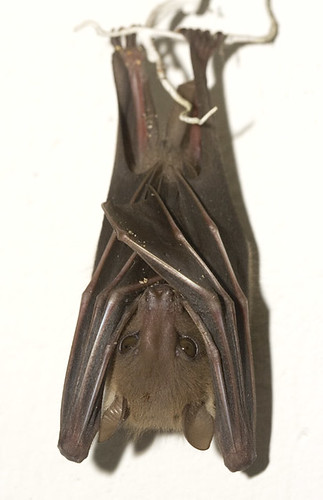
Common fruit bat, Singapore;
(Photo by Marcus)
The common fruit bat, otherwise known as the lesser dog-faced fruit bat, feeds on fruit and nectar, and is known to roost in trees as well as in buildings. Sometimes, these bats will roost beneath large leaves of plants such as bananas and palms, and construct a tent-like structure by chewing along the midrib of the leaves, creating a shelter that shields the bats from sunlight and rain.
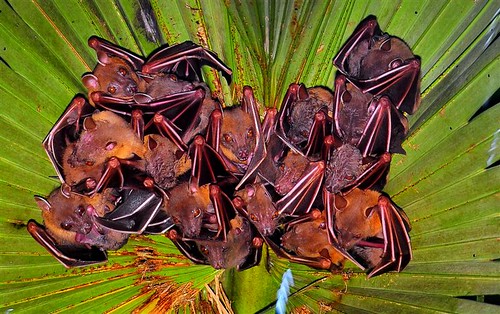
Common fruit bats roosting, Lower Peirce;
(Photo by NatureInYourBackyard)

Common fruit bat feeding on chiku (Manilkara zapota) fruit, Singapore;
(Photo by kwokwai76)

Lesser Asian house bat;
(Photo from Hong Kong Biodiversity Database)
The lesser Asian house bat is the most common of our insectivorous bats, and is not fussy where it comes to choosing a roosting site; large colonies of up to several hundred bats can be found in buildings, hollow trees, and beneath the leaves of palm trees. On more than one occasion, I've seen these bats flying around lamp posts, feasting on the insects drawn to the light.

Large colony of lesser Asian house bats roosting in palm tree;
(Photo by Chen Shiang-Fan)

Lesser Asian house bat, Singapore;
The Malayan flying fox (Pteropus vampyrus) is one of the world's largest bats, with a wingspan of up to 1.5 metres. This species used to be common, but due to widespread hunting and loss of fruit trees, the population has declined greatly. The current status of this species in Singapore is a little confusing. According to A Guide to the Threatened Animals of Singapore, which was published in 1995, populations still exist in the Central Catchment Area, Pulau Ubin, Pulau Tekong and the Singapore Botanic Gardens.
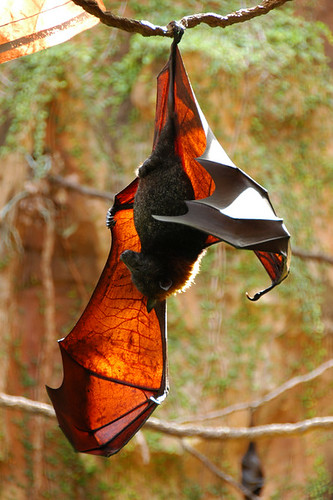
Malayan flying fox, Disney's Animal Kingdom Park;
(Photo by Scottwdw)
However, my copy of Wild Animals of Singapore, which was published last year, doesn't include the Malayan flying fox in the Species Identification Guide, and lists it as a visitor to Singapore in the checklist. This appears to be corroborated by the Ecology Asia website, which states that 'there are no known roosts in Singapore, but visits by small flocks from neighbouring countries occur when there are trees fruiting in the Central Catchment Forest.'
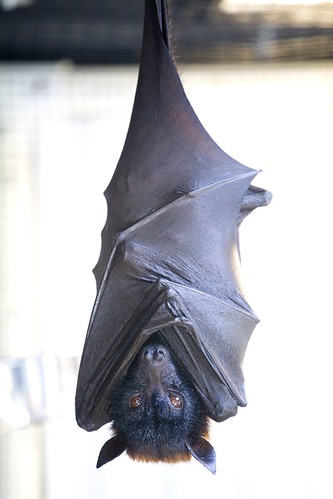
Malayan flying fox, Oakland Zoo;
(Photo by Thomas Hawk)
Not many people seem to be aware of the ecological value of bats. The insectivorous species are significant insect predators, while others play an indispensable role in pollination and seed dispersal. Many people are surprised when I tell them that durians are pollinated chiefly by bats!
Bats can be very challenging to study; after all, many species are small and almost impossible to identify on the wing, and for many of us, the most we will ever get are fleeting glimpses as they flit around at high speed. Good luck trying to identify that nondescript brown blur that just flew past. Many of their calls occur at frequencies beyond our hearing abilities, necessitating the use of special equipment. Not to mention that they are nocturnal, a fact that presents even more challenges to researchers trying to study bat ecology and behaviour.
Using mist nets can provide valuable data, but might still be inadequate in constructing a comprehensive overview of bat numbers and diversity. Different species of bats fly at different heights, and some might go about their nightly activities above the forest canopy, well beyond the range of any net.
There's plenty to discover about Singapore's bats. An article published earlier this year revealed the rediscovery of the bicoloured leaf-nosed bat, a species thought to be extinct locally, as well as the discovery of Hardwicke's woolly bat (Kerivoula hardwickii), a new species record for Singapore.
T. M. Leong & K. K. P. Lim. 2009. Noteworthy microchiropteran records from the Bukit Timah and Central Catchment Nature Reserves, Singapore. Nature in Singapore, 2, 83-90.
Before that, a survey of bats had shown the presence of 3 species not previously recorded in Singapore, the Malayan slit-faced bat (Nycteris tragata), Blyth's horseshoe bat (Rhinolophus lepidus), and lesser tube-nosed bat (Murina suilla), but also suggested that 8 insect-eating species had become locally extinct. 1 of those species thought to be extinct was the bicoloured leaf-nosed bat, which if you recall, was subsequently rediscovered.
Pottie, S. A., Lane, D. J. W., Kingston, T. & Lee, B. P. Y-H. 2005. The microchiropteran bat fauna of Singapore. Acta Chiropterologica, 7(2), 237-247.
Another very interesting study looks at the decline in bat diversity in Singapore. By taking into account bat species found in Peninsular Malaysia, Sumatra and Borneo, but not in Singapore, the researchers suggest that the decline in bat species has been much more calamitous than 19th and 20th century records would suggest. There are also possible implications for species loss elsewhere in tropical Southeast Asia, where the loss and fragmentation of rainforests threaten the survival of numerous bat species.
Lane, D. W. J., Kingston, T. & Lee, B. P. Y-H. 2006. Dramatic decline in bat species richness in Singapore, with implications for Southeast Asia. Biological Conservation, 131(4), 584-593.
Before ending off, I guess it's only fair that I try and come up with some practical solutions for the person with a bat in her kitchen. It might be possible to close the door but leave the windows open, and then try to chase the bat out of the house. It might be better to try doing that in the late afternoon or early evening, when the bat is ready to fly off for a night of foraging anyway.
Under no circumstances should one try to catch the bat with bare hands; in the struggle, the thin bones of the bat might be snapped in two, or its delicate wings might be torn. Besides, bats have sharp teeth, and I won't be surprised if they use them in self-defense once in a while. Unlike in other countries, we don't have to be afraid of catching rabies from being bitten by a bat. Nonetheless, there are a number of other potentially dangerous diseases that may be transmitted between bats and humans, so like all other wild animals, it is best to keep one's distance and to take the necessary precautions when coming into contact with wildlife.
Still, I know of people who have small flocks of common fruit bats roosting in their homes, which I have to admit is rather neat. Can't imagine the noise made by the squabbling bats and the shower of guano though...